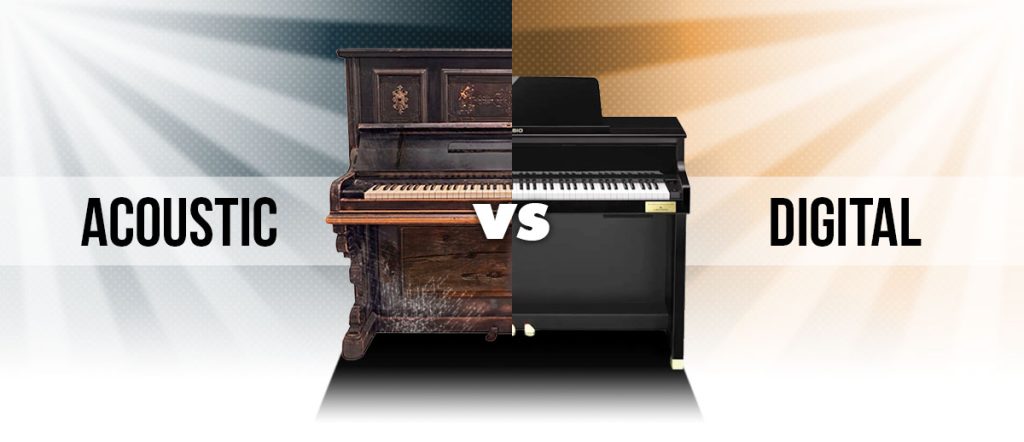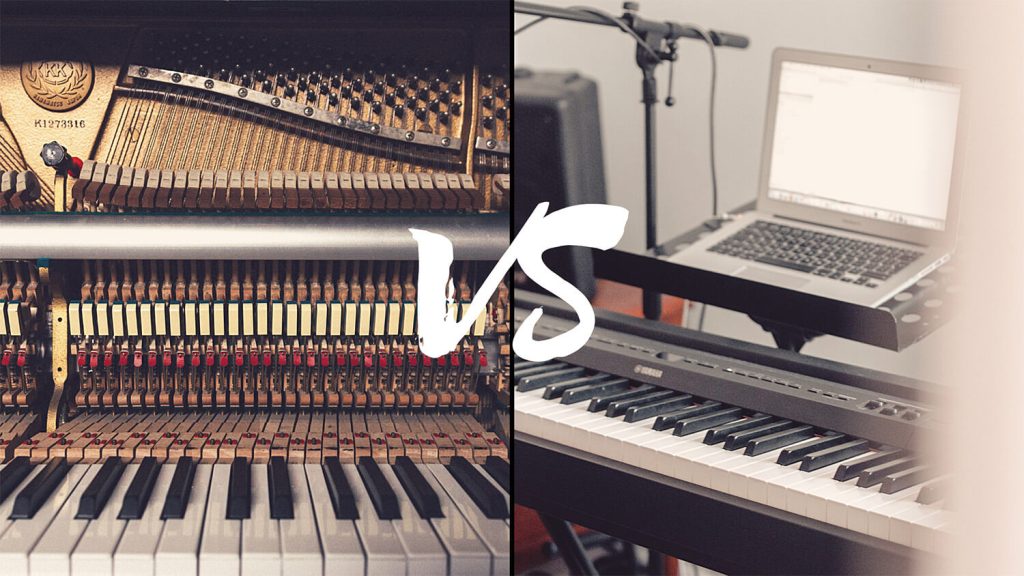Blog
Digital vs Acoustic Piano: Which One Should You Buy?
Choosing between a digital and an acoustic piano is one of the first and most important decisions for anyone learning to play the piano. Both types of pianos offer unique advantages and potential drawbacks, and the best choice depends on your personal needs, goals, space, and budget. In this article, we’ll compare digital and acoustic pianos to help you make an informed decision and choose the one that best suits your lifestyle and musical aspirations.
1. Sound Quality: The Heart of the Piano Experience
Sound is arguably the most noticeable difference between digital and acoustic pianos. While both produce beautiful music, the quality of sound differs significantly due to the way the sound is created.

Acoustic Pianos
- Natural Sound: Acoustic pianos generate sound through hammers striking strings, producing a rich, organic tone that is difficult to replicate digitally. The resonance of the strings and soundboard creates a depth and warmth that many musicians find irreplaceable.
- Dynamic Range: Acoustic pianos offer an extensive dynamic range — the ability to play from the softest pianissimo to the loudest fortissimo. The physical mechanics of the instrument give it an expressive quality that feels more responsive to the touch.
Digital Pianos
- Pre-recorded Sound Samples: Digital pianos rely on sound samples of acoustic pianos, usually recorded from high-quality pianos in a studio. While the sound can be surprisingly realistic, especially in higher-end models, it generally lacks the warmth and depth of an acoustic piano.
- Customization: Many digital pianos offer the option to switch between various instrument sounds (e.g., strings, organ, harpsichord). This versatility can be an advantage for musicians who want to experiment with different sounds.
Which Is Best for Sound?
- If sound quality is your primary concern, then an acoustic piano is likely the better choice due to its richer, more nuanced tone.
- If you’re a beginner or intermediate player, or you need versatility, a digital piano with high-quality sound samples may be sufficient for most needs.
2. Feel and Touch: Key Action and Response
The feel of the keys is another crucial factor to consider, especially for beginners who want to develop proper finger technique.
Acoustic Pianos
- Weighted Keys: Acoustic pianos have fully weighted keys, which means that the keys feel heavy, especially in the lower register. This is essential for building finger strength, control, and playing technique. The resistance provided by the hammers inside an acoustic piano closely mimics the way your fingers would feel when pressing down on real strings.
- Responsive Touch: The touch on an acoustic piano is incredibly responsive, meaning that subtle changes in how you press the keys (harder or softer) are reflected in the volume and tone. This creates a highly expressive playing experience.
Digital Pianos
- Weighted vs. Non-Weighted Keys: Many digital pianos feature weighted keys to replicate the feel of an acoustic piano, especially higher-end models. Some cheaper models may have non-weighted keys, which can feel “plastic” and less realistic.
- Key Action: Digital pianos often feature graded hammer action (GHA), which simulates the heavier touch of lower notes and lighter touch in the higher registers. However, even the best digital pianos can feel less nuanced than acoustic pianos, as they rely on electronic mechanisms instead of hammers and strings.
Which Is Best for Feel and Touch?
- If you’re looking to develop authentic technique and want a more traditional piano experience, an acoustic piano with weighted keys is generally the better option.
- For beginners or those on a budget, a digital piano with weighted keys can still provide a satisfying playing experience, though the feel may not be as rich as that of an acoustic piano.
3. Maintenance and Longevity
Pianos require upkeep, but the level of maintenance varies significantly between digital and acoustic pianos.
Acoustic Pianos
- Tuning: Acoustic pianos require regular tuning, typically every 6 to 12 months, to maintain their sound quality. Tuning an acoustic piano can be expensive, especially if the piano is not maintained regularly.
- Other Maintenance: Acoustic pianos may also require occasional regulation (adjusting the action of the keys) and voicing (tuning the individual strings to make the piano sound more uniform). These types of maintenance can add up over time.
- Longevity: Acoustic pianos, if well-maintained, can last for decades or even centuries. The sound quality and feel will improve with age as the instrument settles in, but only if properly maintained.
Digital Pianos
- No Tuning Required: Digital pianos do not need to be tuned because the sound is generated electronically. This makes them much lower maintenance and more convenient for those who don’t want to worry about upkeep.
- Fewer Parts to Wear Out: While digital pianos do not require tuning, they may need repairs after several years of use. However, with fewer moving parts than an acoustic piano, they are generally less prone to breakdowns.
- Longevity: A high-quality digital piano can last for many years, but technological advancements might make it feel outdated after a decade, especially as software and sound libraries evolve.
Which Is Best for Maintenance?
- Digital pianos win in terms of convenience and low maintenance. There’s no need to tune them or worry about the wear and tear of moving parts.
- If you’re prepared to invest in regular maintenance and enjoy the challenge of preserving a traditional instrument, an acoustic piano may be right for you.
4. Price and Budget
Cost is a significant factor in determining whether to go with a digital or acoustic piano, especially for beginners who may not yet know if they want to commit long-term.
Acoustic Pianos
- Upfront Cost: Acoustic pianos are significantly more expensive than digital pianos. Even entry-level upright pianos can cost several thousand dollars, with grand pianos starting in the $10,000+ range.
- Maintenance Costs: In addition to the upfront cost, you must factor in tuning and general maintenance costs. These can range from $100 to $300 per tuning session, adding to the long-term expense.
Digital Pianos
- Upfront Cost: Digital pianos are generally much more affordable, with prices ranging from a few hundred dollars for entry-level models to $1,500+ for high-end models. You can get a good-quality digital piano with weighted keys in the $500-$1,000 range, which makes them very accessible to beginners.
- No Ongoing Costs: Unlike acoustic pianos, digital pianos require little to no ongoing expenses, making them a more budget-friendly option in the long run.
Which Is Best for Price?
- If you’re on a tight budget and need something affordable, digital pianos are the clear winner. They offer excellent value for beginners and come with a range of features to enhance your practice.
- If you have the budget for it and are looking for a long-term investment in an instrument that can last decades, an acoustic piano may be a better fit, despite the higher initial cost and ongoing maintenance expenses.
5. Space Considerations
Both types of pianos have specific space requirements that can affect where you place the instrument in your home.

Acoustic Pianos
- Large Size: Acoustic pianos, particularly grand pianos, take up a lot of space. Even upright pianos can be quite bulky and require a designated area in your home. They are also heavy and difficult to move.
- Room Acoustics: Acoustic pianos need to be placed in a room where the acoustics will complement the natural resonance of the instrument. Too much humidity or drastic temperature changes can affect the piano’s tuning and condition.
Digital Pianos
- Compact and Portable: Digital pianos are much more compact, lightweight, and easier to move. They can be placed anywhere and are ideal for smaller spaces such as apartments or shared rooms.
- No Sensitivity to Environmental Factors: Unlike acoustic pianos, digital pianos are not as sensitive to humidity, temperature, or other environmental factors. This makes them more adaptable to different living situations.
Which Is Best for Space?
- If you have limited space, a digital piano is undoubtedly the better choice. It can be easily stored, moved, and doesn’t require the space that an acoustic piano demands.
- If you have the space and desire the authenticity of an acoustic piano, an upright acoustic piano is a beautiful addition to any home.
Conclusion: Digital vs Acoustic Piano
When deciding between a digital and an acoustic piano, there is no one-size-fits-all answer. Your choice will depend on your priorities, such as sound quality, touch and feel, maintenance requirements, budget, and space availability.
- Digital pianos are an excellent choice for beginners, those on a budget, and individuals with limited space or a need for portability. They offer lower maintenance costs, a variety of sounds, and a more affordable price point.
- Acoustic pianos, on the other hand, provide a more authentic playing experience with superior sound and touch, making them the preferred choice for serious pianists and those who have the space and budget to maintain a traditional instrument.
Ultimately, the right piano for you depends on your personal preferences and how committed you are to learning the piano.


